Sports Specific
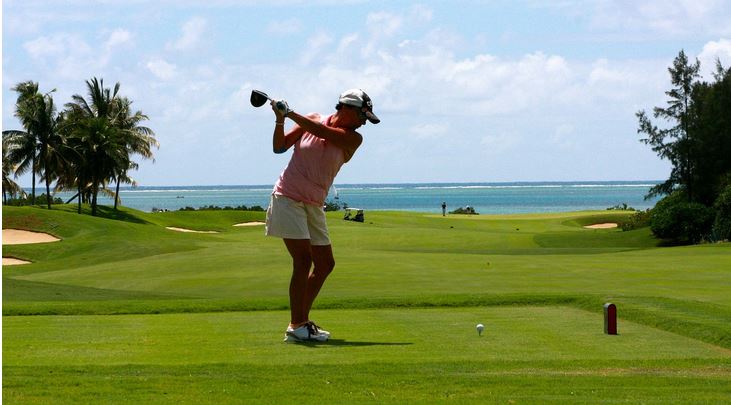
Pilates Mat Exercises to Improve Torso Rotation for Golfers
Many consider golf to be a sport of choice for non-athletes. This really couldn’t be further from the truth. Golf requires a great deal of athleticism which requires both mental and physical strength. In regards to physical ability, a golfer must be well coordinated and strong as well as flexible in many areas to achieve a good, consistent swing.
A key physical factor in the golf swing is the ability to rotate the upper body around a stable lower body and vice versa. The ability to do this well will enhance power production by increasing elastic energy, help keep the golf club on the proper swing plane and can also eliminate many different swing faults.
So how do you know if your golfer can separate their upper and lower body? There is a way to test ability to rotate the upper body around the lower body and also to test rotation of the lower body around a stable upper body. This article addresses rotating the upper body around a stable lower body. The test to do so is called the Torso Rotation Test.
Torso Rotation Test
- Have the golfer set up in their golf posture (he/she will know what you mean) with their arms across their chest, hands on opposite shoulders
- Ask the golfer to hold their hips completely still while they rotate their torso (belt buckle stays forward as shoulders rotate around)
What to look for:
- The hips should not move, they should stay in place
- Note if the client can rotate further to one side than the other
If your client is unable to do this movement without bringing their hips along, stabilize the hips by holding them in place. If this allows the shoulders to rotate further, the client has a problem with hip stability. If the client still has problems trying to rotate their shoulders, they have a mobility problem with the torso. You may find that both hip stability and torso mobility are compromised.
Once you have determined if your golfer has limited ability to rotate, you can design a program to help correct the problems. Hip stability can be caused by issues with core strength and/or lower body strength. Specifically the gluteals must be addressed as well as the obliques and multifidi because they are all stabilizers of the hips. Torso mobility issues can be caused by tightness in the pecs, shoulders, lats, low back and hip flexors as well as core strength.
Pilates Mat Exercises to Address Hip Stability
Supine Leg Circles Exercise
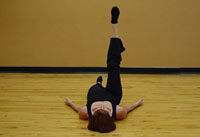
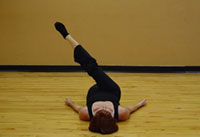
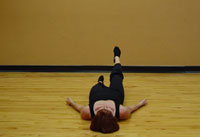
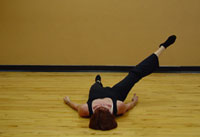
- Lie supine on a mat extending one leg straight out on the floor while the other leg extends toward the ceiling, with the pelvis in neutral
- Inhale and bring the lifted leg across the midline of the body
- Exhale as you start to lower the leg and circle it around, back to the start position
- Perform 5-8 repetitions and then reverse the direction by inhaling to open the leg out to the side and exhaling to lower and complete the circle. The movement should be even and smooth, not bouncy or erratic. The upper body should be still with little to no tension while keeping the hips from rotating or rocking.
- Bend one or both knees for those with tight hamstrings and/or hip flexors
Forearm Plank Exercise (or on hands to increase intensity)
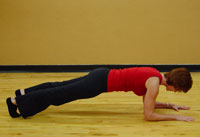
Begin in a quadruped position with forearms and knees on the floor. While remaining on the forearms, inhale and extend the legs out into a modified push-up position making sure that the elbows are directly below the shoulders Hold the position while continuing to breathe. Hold for as long as form can be maintained. Return to the knees and release rear end towards heels to rest low back. Repeat 2 or 3 times .
Side Plank Exercise (or on hand to increase intensity)
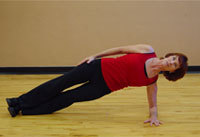
Lie on the right side with the elbow below the shoulder. Legs are extended and long with the lateral malleolous aligned with the hip and shoulder. Legs can be stacked or staggered Inhale and lift the right hip and thigh off the floor trying to support the body on the elbow (forearm) Exhale to hold position continuing to breathe as long as form can be maintained. Avoid pressing the top arm into the side, try to keep it relaxed. The shoulders and hips should remain stacked and stabilized without sinking into the supporting side. The neck should stay long and aligned with the spine Repeat on the left side. Perform 2-3 repetition.
Swimming Exercise

This video illustrates the Swimming exercise. This exercise is good for core stabilization, upper back extension and hip extension. This is good to improve back strength and those deep abdominal stabilizers.
Swimming targets the transversus abdominis, obliques to prevent rotation, erector spinae, gluteals, hamstrings, and deltoids. Avoid rocking or rotating in the torso. Reach long out of your hands and feet. Focus on stabilizing the scapulae to keep shoulders away from the ears. Keep looking directly at the floor to keep the head and neck in neutral.
Pilates Mat Exercises to Address Torso Mobility
Arm Circles Exercise
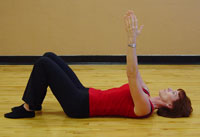
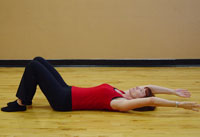
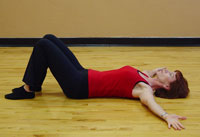
- Lie supine with knees bent and feet hip-distance apart, arms by side, pelvis neutral
- Reach arms to the ceiling as you inhale and begin to reach them overhead while maintaining the abdominal connection and stabilizing the scapulae.
- Exhale to continue the circle reaching the arms around and finishing back by the side.
- Inhale to reach to the ceiling and begin again, completing 3-5 repetitions, before reversing the direction for 3-5 more repetitions.
Spine Twist Exercise
This video illustrates the Pilates Spine Twist exercise. This exercise is great for spinal rotation.
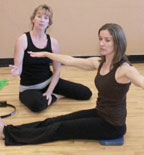
The Spine Twist exercise targets the transversus abdominis, pelvic floor, obliques and scapular stabilizers. Focus on maintaining abdominal contraction to prevent extension of the lumbar and thoracic spine. Maintain scapular stabilization and avoid ballistic movement. Modify this exercise by sitting on a towel or pad to assist with tight low back, hip flexors and/or hamstrings.





